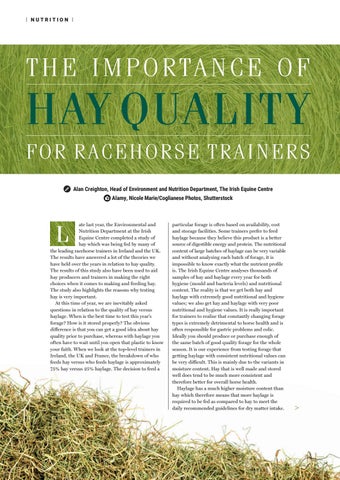| NUTRITION |
T H E I M P O R TA N C E O F
HAY QUALITY
FO R R AC E H O R S E T R A I N E R S Alan Creighton, Head of Environment and Nutrition Department, The Irish Equine Centre Alamy, Nicole Marie/Coglianese Photos, Shutterstock
L
ate last year, the Environmental and Nutrition Department at the Irish Equine Centre completed a study of hay which was being fed by many of the leading racehorse trainers in Ireland and the UK. The results have answered a lot of the theories we have held over the years in relation to hay quality. The results of this study also have been used to aid hay producers and trainers in making the right choices when it comes to making and feeding hay. The study also highlights the reasons why testing hay is very important. At this time of year, we are inevitably asked questions in relation to the quality of hay versus haylage. When is the best time to test this year’s forage? How is it stored properly? The obvious difference is that you can get a good idea about hay quality prior to purchase, whereas with haylage you often have to wait until you open that plastic to know your faith. When we look at the top-level trainers in Ireland, the UK and France, the breakdown of who feeds hay versus who feeds haylage is approximately 75% hay versus 25% haylage. The decision to feed a
54
TRAINERMAGAZINE.COM ISSUE 70
particular forage is often based on availability, cost and storage facilities. Some trainers prefer to feed haylage because they believe this product is a better source of digestible energy and protein. The nutritional content of large batches of haylage can be very variable and without analysing each batch of forage, it is impossible to know exactly what the nutrient profile is. The Irish Equine Centre analyses thousands of samples of hay and haylage every year for both hygiene (mould and bacteria levels) and nutritional content. The reality is that we get both hay and haylage with extremely good nutritional and hygiene values; we also get hay and haylage with very poor nutritional and hygiene values. It is really important for trainers to realise that constantly changing forage types is extremely detrimental to horse health and is often responsible for gastric problems and colic. Ideally you should produce or purchase enough of the same batch of good quality forage for the whole season. It is our experience from testing forage that getting haylage with consistent nutritional values can be very difficult. This is mainly due to the variants in moisture content. Hay that is well made and stored well does tend to be much more consistent and therefore better for overall horse health. Haylage has a much higher moisture content than hay which therefore means that more haylage is required to be fed as compared to hay to meet the daily recommended guidelines for dry matter intake.
